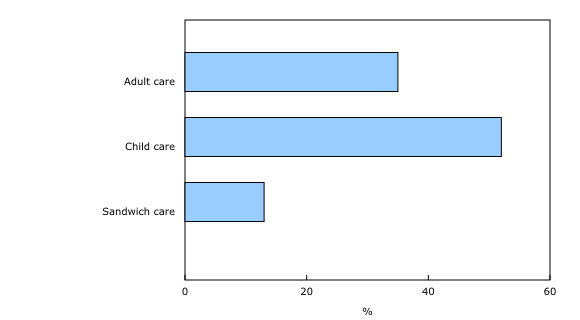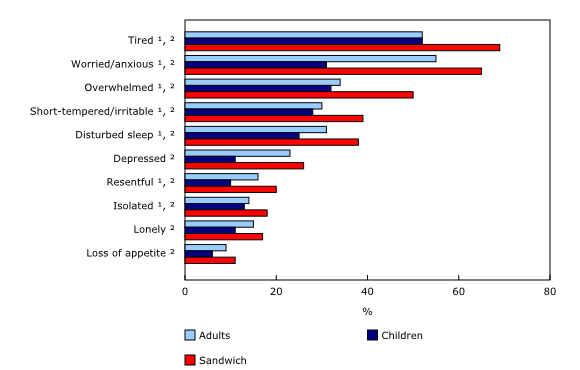[Article] Study: "Sandwiched" between multiple unpaid caregiving responsibilities

[Article] Study: "Sandwiched" between multiple unpaid caregiving responsibilities
Released: 2024-04-02
Who provides unpaid care in Canada's care economy? In 2022, 13.4 million Canadians aged 15 years and older (42%)—over two in five people in this age group—provided unpaid care in the previous 12 months to children younger than 15 years old or to youth aged 15 years and older and adults with a long-term condition or disability. Of these unpaid caregivers, 13% provided care to both of these care-dependent groups, meaning that 1.8 million Canadians older than 15 years were "sandwiched" between multiple care responsibilities.
Chart 1 
Percentage of unpaid care provision in the population aged 15 years and older in the previous 12 months, by care receiver
Using data from the Canadian Social Survey – Well-being and caregiving (Wave 6), a new study sheds light on the landscape of unpaid caregiving in Canada in 2022. The study provides a detailed portrait of sandwich caregivers for the first time in nearly 20 years, including who these caregivers are, how much care they provide and to whom, and the impacts of this unpaid caregiving. Exploring how Canadians provide care, especially after the advent of the COVID-19 pandemic, is important for expanding our understanding of Canada's care economy. As 2024 marks the 30th anniversary of the International Year of the Family, this study contributes to knowledge on the evolving landscape of families in Canada.
In 2022, women (7%) were slightly more likely to be sandwich caregivers than men (5%) in the 12 months preceding the survey. This type of caregiving was most common among adults in prime working age groups, as nearly 3 in 10 of these caregivers were aged 35 to 44 years (29%).
Caregivers were most likely to be sandwiched between their aging parents and their children younger than 15 years (34%). However, multiple caregiving responsibilities go beyond this more typical arrangement. For example, sandwich caregivers also juggled caring for their parents and their grandchildren younger than 15 years (15%), their spouse or partner and their children younger than 15 years (8%), or their spouse or partner and their grandchildren younger than 15 years (7%).
Chart 2 
Impacts on health and well-being because of caregiving responsibilities in past 12 months, by type of caregiver
Having multiple caregiving responsibilities was associated with a higher likelihood of experiencing negative impacts on health and well-being. For example, in 2022, 86% of sandwich caregivers reported at least one negative impact on their physical health and well-being, compared with 74% of caregivers for only adults and 62% of caregivers for only children. Large proportions of sandwich caregivers were most likely to report feeling tired (69%), worried or anxious (65%), and overwhelmed (50%) as a result of their caregiving responsibilities.
Being sandwiched was also associated with unpaid caregivers' material well-being. In 2022, just over one-third (35%) of sandwich caregivers said they experienced financial hardship in the previous 12 months due to their multiple caregiving responsibilities. Further, two-thirds (66%) of sandwiched caregivers who were not retired reported that their caregiving responsibilities impacted their employment or job-seeking activities. For example, sandwich caregivers were more likely than other unpaid caregivers to have adjusted their schedule, reduced their hours or given up work opportunities because of their caregiving.
The study ""Sandwiched" between unpaid care for children and care-dependent adults: A gender-based study" is now available as part of Spotlight on Canadians: Results from the General Social Survey (Catalogue number
89-652-X).
The infographic, "Who are the "sandwich caregivers" in Canada?," which is part of Statistics Canada — Infographics (Catalogue number
11-627-M), is also available.
-
By
Statistics Canada
-
Published
Apr 16, 2024
-
Subject Area
-
Audience
-
Category
Newsletter
Sign up for the Healthy Aging CORE Alberta e-news to keep up-to-date with activity from the platform and the Community-Based Seniors Services (CBSS) sector across the province.


